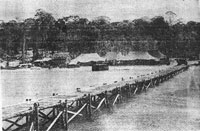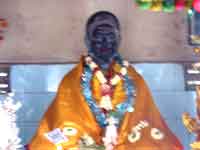|
HISTORY & LEGEND
The history of Sihanoukville goes back only as far
as 1955 when the area was known as Kampong Som. In
August of that year, a French/Cambodian construction
team cut a base camp into the unoccupied jungle
where the Hawaii Seaview Restaurant now sits.
|
They laid the
groundwork for the construction of the new Port
of Kampong Som - a project that had been set
into motion by the 1954 dissolution of French
Indochina.
Prior to 1954,
Cambodia maintained international sea trade via
the Mekong. But the end of Indochina meant the
Mekong delta reverted to the control of Vietnam.
Seeking unfettered access to the ocean, plans
were made to construct a new ocean port. Kampong
Som was selected for water depth and ease of
access. |

 |
Construction of the port
and Route 4 (the road to Phnom Penh) was carried out
from 1955-1960. Funds for construction of the port
came from France, and from the USA for the road. The
town began as housing for workers just south of the
port. Upon completion, the town was renamed
Sihanoukville in honor of the King.
Sihanoukville’s heyday
came in the 1960s. Although Kep was more popular as
a holiday destination, the commercial success of the
port led to a flurry of construction and expansion
including the construction of the Independence Hotel
(abandoned but still still exists on Independence
Beach in a dilapidated state ), the original Angkor
Brewery (closed in 1975 and reopened in 1991), a
Truck & Tractor Plant, Wat Chotynieng (aka Wat Leu),
St Michael's Catholic Church (constructed in 1960,
closed in 1975 and reopened in 1993), dozens of
villas on Ochheuteal Beach (destroyed in the 1980s)
and other structures. There was also a second phase
of port construction, which began in 1965 and halted
with the Lon Nol coup d'etat of 1970.
 |
Sihanoukville entered
the history of the American/Vietnam conflict
when, during the late 1960’s and early 70’s, it
served as a transit point for weapons bound for
anti-American forces in Vietnam. The town’s most direct
involvement came on May 13, 1975 when the Khmer
Rouge captured the S.S. Mayaguez, a U.S. container
ship. |
As part of an attempt to release the ship, the
U.S. attacked Koh Tang, an island near Sihanoukville,
and met fierce resistance, suffering heavy losses.
American bombers struck the naval base at Ream,
warehouses at the Port, the old air field, the train
yard and the oil refinery north of town. The ship
and its crew were released May 15, during the
battle. Check out
http://www.usmm.org/mayaguez.html for more
information.
During the UN sponsored
elections in 1992 and 1993, Sihanoukville played
host to the Australian, Belgian and French
contingents of UNTAC (United Nations Transitional
Authority in Cambodia). After the elections, foreign
tourists started coming to Sihanoukville for the
first time, but tourism came to an abrupt halt with
the tragic 1994 Khmer Rouge murders of 3 backpackers
taken from a train on the way to Sihanoukville , and
of 3 expatriates taken from a taxi on Route 4. With
the 1997-98 demise of the Khmer Rouge and the
political/military stability of the last couple of
years, both the road and the train are now (in 2000)
considered safe, at least from any military threat.
But political and legal fallout of the murders
continue as the home countries and relatives of the
victims demand justice, and the UN and Cambodian
government struggle with the political and legal
complexities of bringing the perpetrators to trial.
History Picture #1 -
Kampong Som base camp, 1955
History Picture #2 -
Kampong Som during port construction, August 1957
History Picture #3 -
US Defense Department map of oil refinery bombed in
Mayaguez incident. May, 1975
LEGEND
|
 |
At the crest of the Pich
Nil Pass on Route 4 dozens of spirit houses line the
road. Many of the houses are maintained for Ya-Mao,
the deity who oversees the southern coastal
region of Cambodia. When traveling Rte 4 people
often display bananas on their dashboard and |
offer the the
bananas, incense and a little money to Ya-Mao at
Pich Nil. The offerings are usually made with the
prayer for safe travels. There seem to be no two
identical tellings of the legend. In one telling, Ya-Mao
was the wife of a village chief in the area of
Ream.
Her husband was forced
by work to spend months away from her in Koh Kong.
One rainy season she grew lonely for him and took a
Koh Kong bound boat to meet him. On the way the boat
was swept away in a storm, drowning everybody,
including Ya-Mao.
|

The main spirit house at
Pich Nil is adorned with phallic symbols but why Ya-Mao
makes this demand is a matter of debate. |
But her spirit was
powerful and through dreams and spirit possessions
she made it known that she was overseeing the
southern coast and protecting the fishermen and
villagers. She required only their good behavior and
occasional offerings of phallic symbols.
 |
Some people
say that she was seeking this in her ill-fated trip
and so still desires it. Others say that she is
angry at men because she died trying to get to her
husband and wants a symbol of a severed phallus.
Sidestepping the debate some more conservative
members of the community think that Ya-Mao is now
too old for phallic symbols and requires only
bananas.
Phallic symbol offerings
can still be seen on the beaches near fishing
villages, usually in the form of a stick and incense
stuck in the sand under a tree. Wat Khrom in
Sihanoukville maintains a small but significant
temple for Ya-Mao.
Legend Picture #1 -
Spirit houses at Pic Nil Pass about 120km south of
Phnom Penh
Legend Picture #2 -
Ya-Mao at Pic Nil Pass
Legend Picture #3 -
Ya-Mao at Wat Krom in Sihanoukville
|
